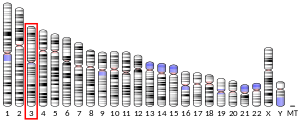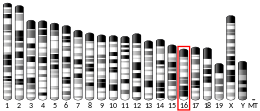EIF2B5
Translation initiation factor eIF-2B subunit epsilon is a protein that in humans is encoded by the EIF2B5 gene.[5][6]
Interactions
EIF2B5 has been shown to interact with EIF2B2[7] and EIF2B1.[7][8]
gollark: HelloBoi's wise wisdom being wise as ever.
gollark: Yes, borrow checkers are free and experience costs something like £40/hour.
gollark: Java use is very unethical.
gollark: This is NOT acceptable.
gollark: *Java*? Really?
References
- GRCh38: Ensembl release 89: ENSG00000145191 - Ensembl, May 2017
- GRCm38: Ensembl release 89: ENSMUSG00000003235 - Ensembl, May 2017
- "Human PubMed Reference:". National Center for Biotechnology Information, U.S. National Library of Medicine.
- "Mouse PubMed Reference:". National Center for Biotechnology Information, U.S. National Library of Medicine.
- Asuru AI, Mellor H, Thomas NS, Yu L, Chen JJ, Crosby JS, Hartson SD, Kimball SR, Jefferson LS, Matts RL (Jul 1996). "Cloning and characterization of cDNAs encoding the epsilon-subunit of eukaryotic initiation factor-2B from rabbit and human". Biochimica et Biophysica Acta. 1307 (3): 309–17. doi:10.1016/0167-4781(96)00054-1. PMID 8688466.
- "Entrez Gene: EIF2B5 eukaryotic translation initiation factor 2B, subunit 5 epsilon, 82kDa".
- Anthony TG, Fabian JR, Kimball SR, Jefferson LS (Jun 2000). "Identification of domains within the epsilon-subunit of the translation initiation factor eIF2B that are necessary for guanine nucleotide exchange activity and eIF2B holoprotein formation". Biochimica et Biophysica Acta. 1492 (1): 56–62. doi:10.1016/S0167-4781(00)00062-2. PMID 10858531.
- Ewing RM, Chu P, Elisma F, Li H, Taylor P, Climie S, McBroom-Cerajewski L, Robinson MD, O'Connor L, Li M, Taylor R, Dharsee M, Ho Y, Heilbut A, Moore L, Zhang S, Ornatsky O, Bukhman YV, Ethier M, Sheng Y, Vasilescu J, Abu-Farha M, Lambert JP, Duewel HS, Stewart II, Kuehl B, Hogue K, Colwill K, Gladwish K, Muskat B, Kinach R, Adams SL, Moran MF, Morin GB, Topaloglou T, Figeys D (2007). "Large-scale mapping of human protein-protein interactions by mass spectrometry". Molecular Systems Biology. 3 (1): 89. doi:10.1038/msb4100134. PMC 1847948. PMID 17353931.
Further reading
- Leegwater PA, Pronk JC, van der Knaap MS (Sep 2003). "Leukoencephalopathy with vanishing white matter: from magnetic resonance imaging pattern to five genes". Journal of Child Neurology. 18 (9): 639–45. doi:10.1177/08830738030180091101. PMID 14572143.
- Chaudhri MA, Crawford AC (1991). "Carbon determination in human teeth by activation with He-3 ions". Biological Trace Element Research. 26-27: 521–7. doi:10.1007/BF02992708. PMID 1704758.
- Welsh GI, Miyamoto S, Price NT, Safer B, Proud CG (May 1996). "T-cell activation leads to rapid stimulation of translation initiation factor eIF2B and inactivation of glycogen synthase kinase-3". The Journal of Biological Chemistry. 271 (19): 11410–3. doi:10.1074/jbc.271.19.11410. PMID 8626696.
- Kimball SR, Heinzinger NK, Horetsky RL, Jefferson LS (Jan 1998). "Identification of interprotein interactions between the subunits of eukaryotic initiation factors eIF2 and eIF2B". The Journal of Biological Chemistry. 273 (5): 3039–44. doi:10.1074/jbc.273.5.3039. PMID 9446619.
- Welsh GI, Miller CM, Loughlin AJ, Price NT, Proud CG (Jan 1998). "Regulation of eukaryotic initiation factor eIF2B: glycogen synthase kinase-3 phosphorylates a conserved serine which undergoes dephosphorylation in response to insulin". FEBS Letters. 421 (2): 125–30. doi:10.1016/S0014-5793(97)01548-2. PMID 9468292.
- Leegwater PA, Könst AA, Kuyt B, Sandkuijl LA, Naidu S, Oudejans CB, Schutgens RB, Pronk JC, van der Knaap MS (Sep 1999). "The gene for leukoencephalopathy with vanishing white matter is located on chromosome 3q27". American Journal of Human Genetics. 65 (3): 728–34. doi:10.1086/302548. PMC 1377979. PMID 10441579.
- Gomez E, Pavitt GD (Jun 2000). "Identification of domains and residues within the epsilon subunit of eukaryotic translation initiation factor 2B (eIF2Bepsilon) required for guanine nucleotide exchange reveals a novel activation function promoted by eIF2B complex formation". Molecular and Cellular Biology. 20 (11): 3965–76. doi:10.1128/MCB.20.11.3965-3976.2000. PMC 85753. PMID 10805739.
- Anthony TG, Fabian JR, Kimball SR, Jefferson LS (Jun 2000). "Identification of domains within the epsilon-subunit of the translation initiation factor eIF2B that are necessary for guanine nucleotide exchange activity and eIF2B holoprotein formation". Biochimica et Biophysica Acta. 1492 (1): 56–62. doi:10.1016/S0167-4781(00)00062-2. PMID 10858531.
- Williams DD, Price NT, Loughlin AJ, Proud CG (Jul 2001). "Characterization of the mammalian initiation factor eIF2B complex as a GDP dissociation stimulator protein". The Journal of Biological Chemistry. 276 (27): 24697–703. doi:10.1074/jbc.M011788200. PMID 11323413.
- Wang X, Paulin FE, Campbell LE, Gomez E, O'Brien K, Morrice N, Proud CG (Aug 2001). "Eukaryotic initiation factor 2B: identification of multiple phosphorylation sites in the epsilon-subunit and their functions in vivo". The EMBO Journal. 20 (16): 4349–59. doi:10.1093/emboj/20.16.4349. PMC 125262. PMID 11500362.
- Leegwater PA, Vermeulen G, Könst AA, Naidu S, Mulders J, Visser A, Kersbergen P, Mobach D, Fonds D, van Berkel CG, Lemmers RJ, Frants RR, Oudejans CB, Schutgens RB, Pronk JC, van der Knaap MS (Dec 2001). "Subunits of the translation initiation factor eIF2B are mutant in leukoencephalopathy with vanishing white matter". Nature Genetics. 29 (4): 383–8. doi:10.1038/ng764. PMID 11704758.
- Wang X, Janmaat M, Beugnet A, Paulin FE, Proud CG (Oct 2002). "Evidence that the dephosphorylation of Ser(535) in the epsilon-subunit of eukaryotic initiation factor (eIF) 2B is insufficient for the activation of eIF2B by insulin". The Biochemical Journal. 367 (Pt 2): 475–81. doi:10.1042/BJ20020677. PMC 1222905. PMID 12133000.
- Fogli A, Wong K, Eymard-Pierre E, Wenger J, Bouffard JP, Goldin E, Black DN, Boespflug-Tanguy O, Schiffmann R (Oct 2002). "Cree leukoencephalopathy and CACH/VWM disease are allelic at the EIF2B5 locus". Annals of Neurology. 52 (4): 506–10. doi:10.1002/ana.10339. PMID 12325082.
- Fogli A, Dionisi-Vici C, Deodato F, Bartuli A, Boespflug-Tanguy O, Bertini E (Dec 2002). "A severe variant of childhood ataxia with central hypomyelination/vanishing white matter leukoencephalopathy related to EIF21B5 mutation". Neurology. 59 (12): 1966–8. doi:10.1212/01.wnl.0000041666.76863.47. PMID 12499492.
- Fogli A, Rodriguez D, Eymard-Pierre E, Bouhour F, Labauge P, Meaney BF, Zeesman S, Kaneski CR, Schiffmann R, Boespflug-Tanguy O (Jun 2003). "Ovarian failure related to eukaryotic initiation factor 2B mutations". American Journal of Human Genetics. 72 (6): 1544–50. doi:10.1086/375404. PMC 1180314. PMID 12707859.
- van der Knaap MS, van Berkel CG, Herms J, van Coster R, Baethmann M, Naidu S, Boltshauser E, Willemsen MA, Plecko B, Hoffmann GF, Proud CG, Scheper GC, Pronk JC (Nov 2003). "eIF2B-related disorders: antenatal onset and involvement of multiple organs". American Journal of Human Genetics. 73 (5): 1199–207. doi:10.1086/379524. PMC 1180499. PMID 14566705.
This article is issued from Wikipedia. The text is licensed under Creative Commons - Attribution - Sharealike. Additional terms may apply for the media files.




